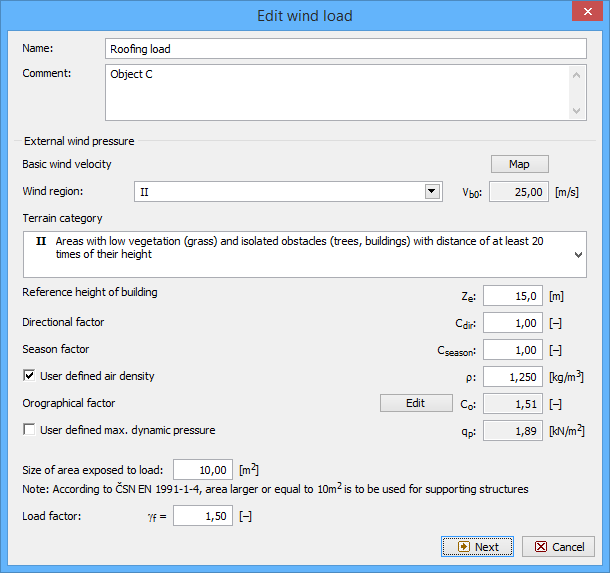This window contains parameters of the wind load. It is divided into two parts: First part contains parameters that are necessary for the calculation of the maximum dynamic pressure, second part is dedicated for the choice of wind load type and its parameters. Switching between these two parts can be done with the help of buttons "Previous"/"Next". Following parameters are placed in the first part:
Wind region | - The wind region may be selected with the help of drop-down menu or map (may be opened using the button "Map"). The value of the fundamental wind velocity vb,0 is selected according to the wind region. An arbitrary value of vb,0 is possible for "user defined" wind region.
|
Terrain category | - The terrain category refers to the terrain roughness on site. The detailed description of all categories is described in the "Annex A" of EN 1991-1-4. The parameters assigned to the selected category are based on the table 4.1. The surrounding terrain with different roughness should be respected during the choice of the terrain category. Rules are given in the chapter A.2 of the standard.
|
Reference height of building | - The reference height of the building Ze is a basic parameter for the calculation of maximum dynamic pressure.
|
Directional factor | - This factor cdir is defined in the chapter 4.2 of EN 1991-1-4.
|
Season factor | - The season factor cseason may reduce wind load for temporary structures, that won't exist during the season with highest wind pressure.
|
Air density | - The recommended value of the air density ρ is 1,25kg/m3.
|
Orography factor | - The orography factor co increases the wind velocity at isolated hills and ridges or cliffs and escarpments. The calculation may be performed in the dedicated window "Orography factor", that may be launched by the button "Edit". The calculation is based on the chapter A.3 of EN 1991-1-4.
|
Maximum dynamic pressure | - The software shows the value of the maximum dynamic pressure qp according to the formula (4.8) of EN 1991-1-4. The user defined value of the pressure may be entered after using the setting "User defined max. dynamic pressure".
|
Size of loaded area | - The loaded area A is used for the calculation of external pressure coefficient. The values cpe,1 are used for loaded areas lower than 1m2. The values cpe,10 are used for loaded areas greater than 10m2. The linear interpolation according to the chapter 7.2.1 is used for intermediate values.
|
Roof | - This options creates the load report for roof. The variety of plans and roof types are available in the software. The rules given in the chapters 7.2.3 (flat roofs), 7.2.4 (mono-pitched roofs), 7.2.5 (duo-pitched roofs) and 7.2.6 of EN 1991-1-4 are considered.
|
Canopy roof | - This options creates the load report for canopy roof. The variety of plans and roof types are available in the software. The rules given in the chapter 7.3 (canopy roofs) of EN 1991-1-4 are considered.
|
Walls of rectangular plan object | - This options creates the load report for walls of rectangular plan buildings. The erbitrary number of calculation levels may be specified for the report. The calculation is based on the chapter 7.2.2.
|
Vault roof | - This options creates the load report for circular cylindrical roofs according to the chapter 7.2.8 of EN 1991-1-4.
|
Dome | - This options creates the load report for domes according to the chapter 7.2.8 of EN 1991-1-4.
|
 Window "Edit wind load"
Window "Edit wind load"